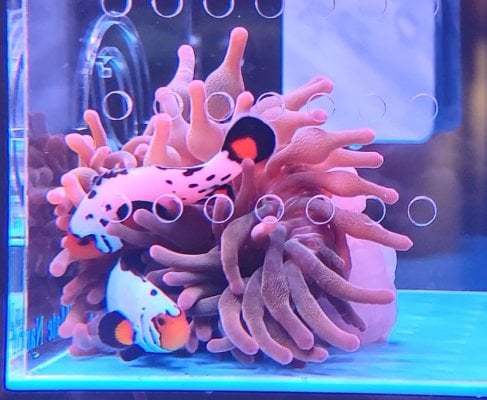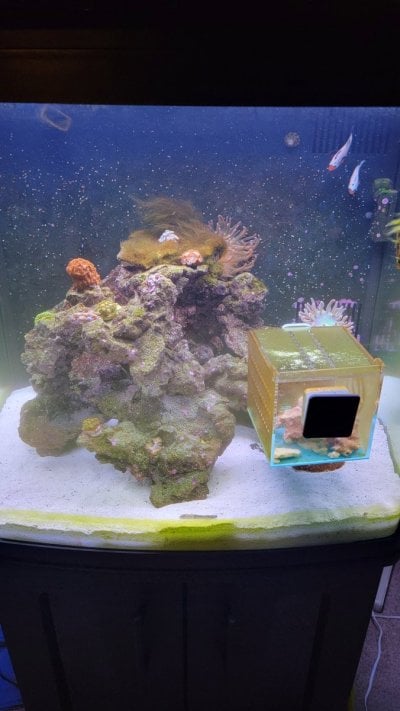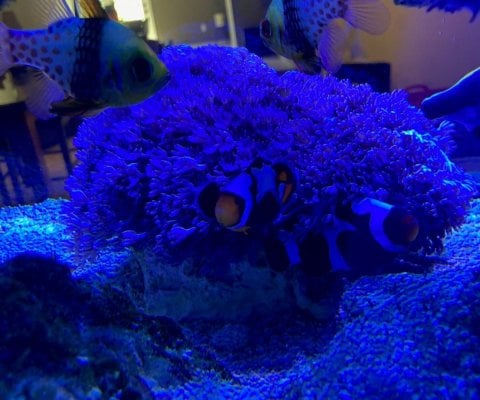As mentioned earlier, gigantea and magnifica are the natural hosts of ocellaris (and perculas, for that matter). And, providing a healthy host even captive bred clownfish usually waste no time being hosted. Research studies suggest that it has to do with chemicals shed by the anemone that the fish essentially smells and knows where to find the anemone. In nature, as soon as the baby clownfish goes from larval stage to baby fry stage it must find an anemone or be eaten. Clownfish are never found living sans anemone in nature. Therefore, it's essential clownfish immediately upon metamorphosis from larval stage find a host. That instinct has not been bred out of clownfish through repeated breeding in captivity without an anemone. I personally have never seen a natural host anemone be rejected by a natural clownfish symbiont species. I've heard people say that's happened, but I think it's safe to say it's practically nonexistent. I've always had captive bred clowns, provided the natural host (because I'm specifically interested in seeing the natural interaction between clowns/anemones as in nature), and the fish go to the anemone pronto. With the species of clowns you have, unfortunately magnifica/gigantea have a much lower survival rates compared to BTAs. Mags/gigantea are quite tough after they acclimate to a tank, but very often they die within weeks after being added to the tank, presumably due to the shipping process compromising their natural immune defenses--with the anemone sadly succumbing to bacterial infections.Okay thank you. Here are a couple pictures of her
Navigation
Install the app
How to install the app on iOS
Follow along with the video below to see how to install our site as a web app on your home screen.
Note: This feature may not be available in some browsers.
More options
You are using an out of date browser. It may not display this or other websites correctly.
You should upgrade or use an alternative browser.
You should upgrade or use an alternative browser.
Will my BTA ever host my clowns?
- Thread starter AlyciaMarie
- Start date
- Tagged users None
Yeah I have heard all of this. It is unfortunate and I do not want to take an anemone in only to have it die. I also do not really have room for one that big so I will keep my BTA, torch, and eventually a hammer, hoping for the best, but not really expecting muchAs mentioned earlier, gigantea and magnifica are the natural hosts of ocellaris (and perculas, for that matter). And, providing a healthy host even captive bred clownfish usually waste no time being hosted. Research studies suggest that it has to do with chemicals shed by the anemone that the fish essentially smells and knows where to find the anemone. In nature, as soon as the baby clownfish goes from larval stage to baby fry stage it must find an anemone or be eaten. Clownfish are never found living sans anemone in nature. Therefore, it's essential clownfish immediately upon metamorphosis from larval stage find a host. That instinct has not been bred out of clownfish through repeated breeding in captivity without an anemone. I personally have never seen a natural host anemone be rejected by a natural clownfish symbiont species. I've heard people say that's happened, but I think it's safe to say it's practically nonexistent. I've always had captive bred clowns, provided the natural host (because I'm specifically interested in seeing the natural interaction between clowns/anemones as in nature), and the fish go to the anemone pronto. With the species of clowns you have, unfortunately magnifica/gigantea have a much lower survival rates compared to BTAs. Mags/gigantea are quite tough after they acclimate to a tank, but very often they die within weeks after being added to the tank, presumably due to the shipping process compromising their natural immune defenses--with the anemone sadly succumbing to bacterial infections.
Maybe they will take to the BTA, it often works. Fingers crossed!Yeah I have heard all of this. It is unfortunate and I do not want to take an anemone in only to have it die. I also do not really have room for one that big so I will keep my BTA, torch, and eventually a hammer, hoping for the best, but not really expecting much
I've been target feeding above the anemone and encouraging the clowns towards the BTA with the net as recommended. They seem to be showing more interest, but nothing ground breaking, yet. Hopefully this will work in the long run. Right now the corner of my tank is "hosting" my clowns. LOL.
yep, same hereI've been target feeding above the anemone and encouraging the clowns towards the BTA with the net as recommended. They seem to be showing more interest, but nothing ground breaking, yet. Hopefully this will work in the long run. Right now the corner of my tank is "hosting" my clowns. LOL.
It took about 6 months but I have a gladiator and maroon mated pair. I tried all the tricks but didn't work. I just let nature take its course. It took about 6 months before they accepted my BTA as a host. One night while I was asleep, the BTA let loose and got sucked into a power head and is now dead. After about another 6 months, they have accepted my pulsing Xenia as a host and are laying their eggs at the base of the rock below the Xenia.I'm aware that it's a loaded question, and that anemones and clowns are going to do what they want to do no matter how hard I try to get them to be besties. But every day that passes that my anemone isn't hosting my clowns makes me sad!
Has anyone ever experimented with trying to encourage and successfully cultivate this symbiotic relationship?
I haven't tried really much of anything except bringing my feeding pipette near the anemone to attract the clowns to it. They'll get close, but as soon as the food is gone, so are the clowns. They definitely know the BTA is there, but are not showing any interest. Both the clowns and BTA were added roughly two months ago. Any advice helps!
Attachments
My paired frostbite clowns and RBTA went into the tank at the same time. I started them in an isolation box to encourage pairing, and within about 3 hours, they were both buried in the anemone. Thrilled! After several more hours the nem was fully open and gorgeous and the clowns were using it for a couch, but it was not anchored in the box, just laying, and its crown was facing away from me. I wanted to send a photo to my buddy, so I opened the box lid to spin it around to face me, and one of the clowns jumped out of the box into the tank proper. I decided that meant it was time to let them be free, so I placed the nem in a likely spot and turned loose the other clown.
Four and a half months later, the clowns have not again acknowledged the RBTA (or another one I added) in any way.
/facepalm
Photos are isolation box move-in day and today's ugly tank photo. They have adopted my magnet in the back right corner as their daytime home, and usually sleep just above the return nozzle.
(Can someone please DM me how to make my photos not be inline like a noob. They're attached, not pasted inline, but they show up that way anyway. I'm really irritated I can't figure it out.)


Four and a half months later, the clowns have not again acknowledged the RBTA (or another one I added) in any way.
/facepalm
Photos are isolation box move-in day and today's ugly tank photo. They have adopted my magnet in the back right corner as their daytime home, and usually sleep just above the return nozzle.
(Can someone please DM me how to make my photos not be inline like a noob. They're attached, not pasted inline, but they show up that way anyway. I'm really irritated I can't figure it out.)


Last edited:
Maroon are much more selective. They just use BTA and Magnifica.
My maroon instantly took to a sebae (I think crispa but I'm not 100% sure on them vs malu) when they went into QT together. My Domino ocellaris took a month or so to adopt their LTA, my wild nigripes pairs took to LTA within hours, my CB pink skunks stubbornly hover just out of reach of their LTA. I have BTA in my pink skunk and naked ocellaris tanks tanks that they pay no attention to at all.
InterestingI put one Anemone in my 20g (now its two) and my clown completely ignores it. I also had two clowns in a 32g with a large anemone and they didn't care about it at all. Same two clowns are now in a large tank and live in the anemones. I seem to notice the smaller tanks its harder to get them to be hosted and I'm not exactly sure why.
Similar threads
- Replies
- 6
- Views
- 340
- Replies
- 6
- Views
- 170
- Replies
- 4
- Views
- 334
- Replies
- 1
- Views
- 184




















